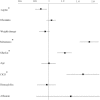Emerging markers of cachexia predict survival in cancer patients
- PMID: 25400234
- PMCID: PMC4239407
- DOI: 10.1186/1471-2407-14-828
Emerging markers of cachexia predict survival in cancer patients
Abstract
Background: Cachexia may occur in 40% of cancer patients, representing the major cause of death in more than 20% of them. The aim of this study was to investigate the role of leptin, ghrelin and obestatin as diagnostic and predictive markers of cachexia in oncologic patients. Their impact on patient survival was also evaluated.
Methods: 140 adults with different cancer diagnoses were recruited. Thirty healthy volunteers served as control. Serum ghrelin, obestatin and leptin were tested at baseline and after a follow-up period of 18 months.
Results: Ghrelin levels were significantly higher in cancer patients than in healthy subjects (573.31 ± 130 vs 320.20 ± 66.48 ng/ml, p < 0.0001), while obestatin (17.42 ± 7.12 vs 24.89 ± 5.54 ng/ml, p < 0.0001) and leptin (38.4 ± 21.2 vs 76.28 ± 17.48 ng/ml, p < 0.0001) values were lower. At ROC analyses the diagnostic profile of ghrelin (AUC 0.962; sensitivity 83%; specificity 98%), obestatin (AUC 0.798; sensitivity 74.5%; specificity 81.5%) and leptin (AUC 0.828; sensitivity 79%; specificity 73%) was superior to that of albumin (AUC 0.547; sensitivity 63%, specificity 69.4%) for detecting cachexia among cancer patients. On Cox multivariate analyses ghrelin (HR 1.02; 95% CI 1.01 - 1.03; p < 0.0001) and leptin (HR 0.94; 95% CI 0.92 - 0.96; p < 0.0001) were significant predictors of death even after correction for other known risk factors such as presence of metastasis and chronic kidney disease.
Conclusion: Ghrelin and leptin are promising biomarkers to diagnose cachexia and to predict survival in cancer patients.
Figures




References
-
- Maltoni M, Nanni O, Pirovano M, Scarpi E, Indelli M, Martini C, Monti M, Arnoldi E, Piva L, Ravaioli A, Cruciani G, Labianca R, Amadori D. Successful validation of the palliative prognostic score in terminally ill cancer patients. Italian multicenter study group on palliative care. J Pain Symptom Manage. 1999;17:240–247. doi: 10.1016/S0885-3924(98)00146-8. - DOI - PubMed
-
- Lacquaniti A, Altavilla G, Picone A, Donato V, Chirico V, Mondello P, Aloisi C, Marabello G, Loddo S, Buemi A, Lorenzano G, Buemi M. Clin Exp Med. 2014. Apelin beyond kidney failure and hyponatremia: a useful biomarker for cancer disease progression evaluation. - PubMed
-
- Berenstein EG, Ortiz Z. Megestrol acetate for the treatment of anorexia-cachexia syndrome (Protocol for a Cochrane Review) Cochrane Libr. 2004;4:1–7. - PubMed
-
- Baiti NB, Walsh D. What is cancer anorexia-cachexia syndrome? A historical perspective. J R Coll Physicians Edinb. 2009;39:257–262. - PubMed
Pre-publication history
-
- The pre-publication history for this paper can be accessed here:http://www.biomedcentral.com/1471-2407/14/828/prepub
MeSH terms
Substances
LinkOut - more resources
Full Text Sources
Other Literature Sources

